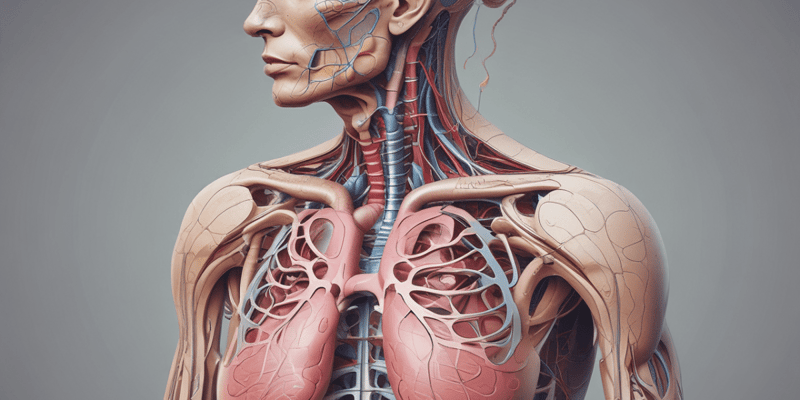15 Questions
What is necessary for inhalation to occur?
Muscular contractions
Which of the following muscles are involved in the process of inhalation?
Both the diaphragm and intercostal muscles
What is the function of the vacuum in the pleural cavity?
To suck the lungs to the thoracic wall/diaphragm
Why are the alveoli unable to suck air in on their own?
Because they are not surrounded by muscle tissue
What is the characteristic of inhalation?
It is an active process
What is the primary reason alveoli are unable to suck air in?
Absence of muscle tissue
What is the role of the vacuum in the pleural cavity?
It sucks the lungs to the thoracic wall
Which of the following is NOT a necessary component of inhalation?
Alveolar muscle contraction
What is the characteristic of the process of inhalation?
It is an active process
Which muscle group is NOT directly involved in the process of inhalation?
Alveolar muscles
What is the primary cause of air molecules moving from one area to another?
Differences in air pressure
What happens to the air pressure in the lungs during inhalation?
It decreases
What is the characteristic of an area with high air pressure?
More air molecules
What is the direction of air molecule movement?
From high to low pressure
What is the relationship between air molecules and pressure?
Air molecules have weight, which presses on anything it touches
Study Notes
Ventilation Process
- Alveoli and surrounding tissues lack muscle tissue, making them incapable of drawing air in on their own.
- Inhalation is an active process that requires muscle contractions.
Muscles Involved in Inhalation
- Diaphragm: plays a crucial role in the inhalation process.
- Intercostal muscles: involved in the contraction process.
Thoracic Cavity
- The pleural cavity contains a vacuum that helps suck the lungs to the thoracic wall and diaphragm.
Ventilation Process
- Alveoli and surrounding tissues lack muscle tissue, making them incapable of drawing air in on their own.
- Inhalation is an active process that requires muscle contractions.
Muscles Involved in Inhalation
- Diaphragm: plays a crucial role in the inhalation process.
- Intercostal muscles: involved in the contraction process.
Thoracic Cavity
- The pleural cavity contains a vacuum that helps suck the lungs to the thoracic wall and diaphragm.
Air Pressure and Movement of Air
- Air molecules exert a downward force, known as air pressure, on objects they come into contact with.
- Air pressure is affected by the density of air molecules in a given space.
High and Low Pressure
- High (positive) pressure is characterized by a high concentration of air molecules in a given space.
- Low (negative) pressure is characterized by a lower concentration of air molecules in a given space.
Movement of Air Molecules
- Air molecules naturally migrate from areas of high pressure to areas of low pressure.
Ventilation and Air Pressure
- The volume changes in the thorax during ventilation (breathing) affect the pressure in the lungs.
- Changes in lung pressure facilitate the influx or efflux of air into or out of the lungs during breathing.
Learn about the process of inhalation, the role of diaphragm and intercostal muscles, and how the pleural cavity affects lung expansion.
Make Your Own Quizzes and Flashcards
Convert your notes into interactive study material.
Get started for free




